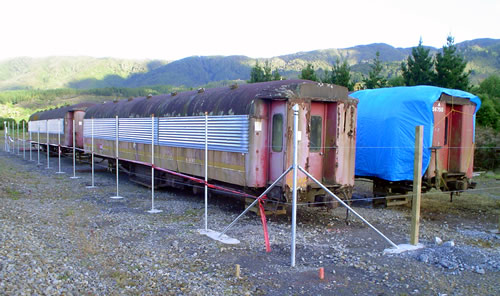
Three 56-foot carriages (from left to right A 2000, A 1916, & A 1988) in storage at Maymorn on 10 December 2005. Photo: Hugh McCracken.
Six carriages donated to the Trust
Six 56-foot railway carriages have been donated by a member of the Rimutaka Incline Railway Heritage Trust. They have been in storage at Ohakune for many years, originally intended for use as accomodation. The Trust is extremely thankful for the support of the Rimutaka Trust in covering most of the transport expenses associated in bringing them to Maymorn. This is an unique opportunity for the railway to secure its own carriages — albeit long-term restoration projects.
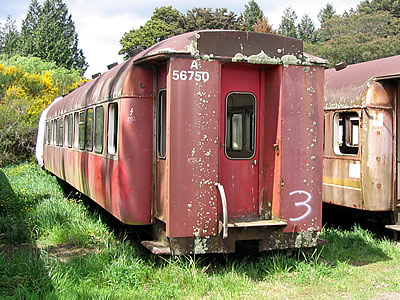
Carriages A 1988 / 56750 (left) and A 1996 / 56113 (right) in storage at Ohakune, 6 November 2005. Photo: Hugh McCracken.
Brief history
56-foot carriages were built in large numbers at Otahuhu and Addington workshops between 1937 and 1944. They were amongst the last carriages that were built with timber car body framing.
Carriages were built in 1st class (with both North and South Island types), 2nd class and sleeping configurations, with windows spaced to match. A fleet of matching guards vans were also built.
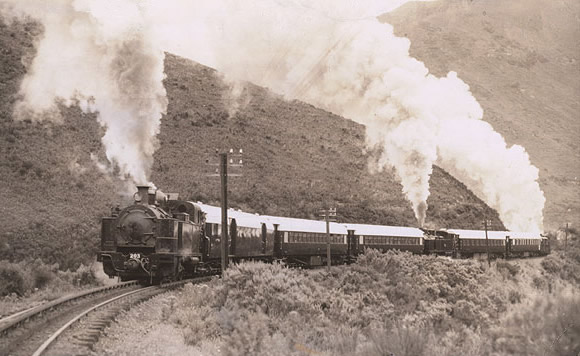
Royal train comprising 56-foot carriages ascending the Rimutaka Incline, hauled by Fell locomotives H 203, H 199 and H 201. Photo: New Zealand Railways E-597, courtesy Springburn Digital Museum.
The 56-foot carriages were intended for use on Main Trunk routes in both islands, but also saw service on many of the provincial routes. They were used on the South Island Limited, Scenic Daylight and other Main Trunk expresses, also on the Opua, Taneatua, New Plymouth and Greymouth Expresses. The Southerner, Northerner and Endeavour Expresses of the 1970s were comprised of refurbished 56-foot carriages. 56-foot carriages were also used for commuter services in Wellington and Auckland, and are still used on the Wairarapa Connection services between Wellington and Masterton. The same carriages are also used on remaining Tranz Scenic services, although most are now fitted with observation windows.
Of relevance to the Rimutaka Incline Railway, the Royal Train for Queen Elizabeth II that passed over the Rimutaka Incline on 15 January 1954 was comprised of 56-foot carriages. North Island Main Trunk expresses were occasionally diverted over the Incline when the Manawatu Line was flooded or otherwise blocked. Modifications to central truss framing was required on some 56-foot carriage designs in order to obtain clearance for the centre rail. Two of the carriages secured by the Trust have been so modified.
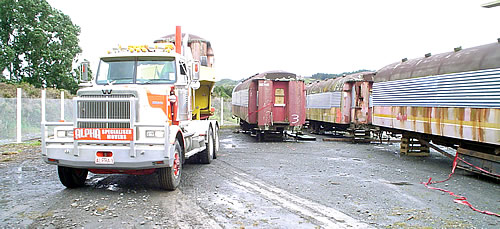
Alpha Specialised Movers delivering the fourth carriage to the Maymorn site, 20 December 2005. A fifth carriage and guards van F605 were on site by the end of the week. Photo: Hugh McCracken.
Carriages A 1916, 2000 and 1988 arrived on Wednesday 7th, Thursday 8th and Friday 9th respectively. Security and presentation of the carriages are top priorities, and the Trust wasted no time in erecting a security fence to enclose and protect them.
- The six vehicles comprise five 56-foot steel-clad main trunk carriages and a matching guard’s van;
- All were retired from service in the early 1990’s,
- Most were retired from Auckland Cityrail urban rail service, though the guard’s van saw Southerner / Endeavour service and latterly in a Telecom demonstration train. Carvan AL2044 came from the Christchurch — Picton passenger train.
- All were sold by Tranz Rail in February/March 1996
- They were transported by rail to Karioi, 10km east of Ohakune
- The carriages were subsequently parted from their bogies, transported and stored at Ohakune for possible chalet accommodation.
- The carriages were advertised for sale on Internet auction site Trade Me during mid-2005
| Original No | TMS No | Year outshopped | Where built | "Ohakune" No | Arrival date at Maymorn |
|---|---|---|---|---|---|
| A1896 | A56113 | 1941 | Otahuhu | 4 | 20 Dec 2005 |
| A1914 | AL2044 | 1940 | Otahuhu | 5 | 21 Dec 2005 |
| A1916 | A56247 | 1939 | Otahuhu | 2 | 7 Dec 2005 |
| A1988 | A56750 | 1943 | Addington | 3 | 9 Dec 2005 |
| A2000 | A56868 | 1940 | Addington | 1 | 8 Dec 2005 |
| F605 | EA67715 | 1944 | Otahuhu | 6 | 23 Dec 2005 |
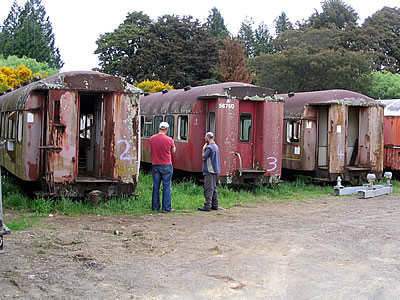
Hugh McCracken and Paul Vincent discussing a possible return to the rails for the carriages formerly at Ohakune, 6 November 2005. Photo: Colin Craddock.
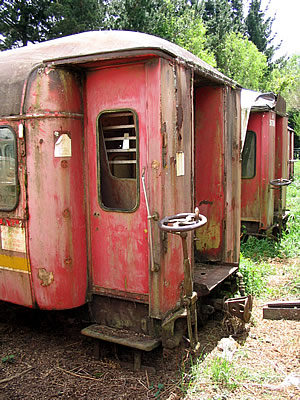
End view of carriage A1896. Photo: Hugh McCracken.
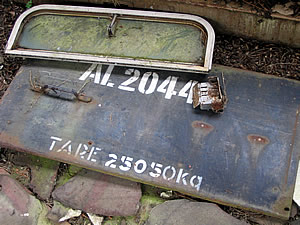
AL2044 battery box cover, tare weight 25050kg. Photo: Hugh McCracken.
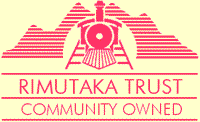
Transport from Ohakune to Maymorn
The Trust was delighted to receive a grant from the Rimutaka Licensing Trust for close to $25,000 towards the costs of relocating the carriages from Ohakune to Maymorn. The Trust would have not been able to secure the carriages without this assistance.
The Trust had to move as quickly as practicable to move the carriages, as construction of a mini-storage facility was well under way on the site. This had already complicated the move, as storage units that had already been built were blocking the exit path for guard’s van F605 (carriage 6).
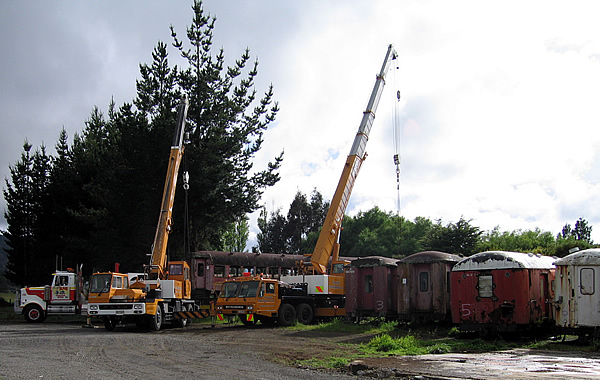
Cranes hired from Ohakune Engineering lift carriage A2000 onto a truck at Ohakune, early on 8 December 2005. Photo: Paul Vincent.
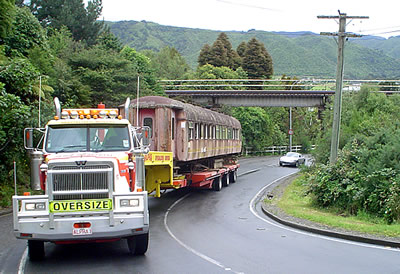
Carriage ‘A’ 1896 / 56113 passes under the Wairarapa line, Mangaroa Hill Road, 20 December 2005. Photo: Hugh McCracken.
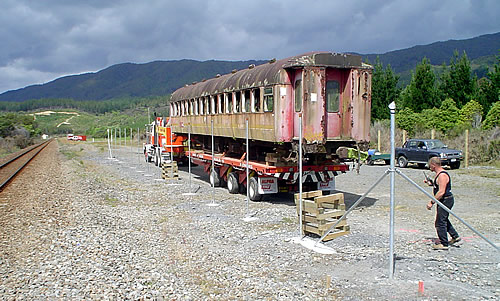
The first carriage, A1916, arrives at Maymorn from Ohakune on 7 December 2005. Notice the security fence, part-built at this stage. Photo: Hugh McCracken.
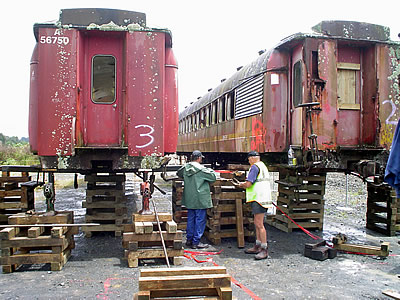
Colin Craddock and Peter Milburn position blocks during lowering operation. Photo: Hugh McCracken.
Carriage fence
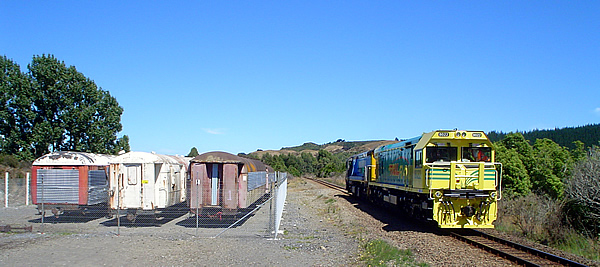
During a test-run on the Wairarapa mainline, DXR8022 passes the nearly-completed carriage fence, 28 January 2006. Photo: Hugh McCracken.
Security fencing for the carriages is nearly complete after many days of concerted effort in straining wire and placing chain-link mesh. To improve security even further, the inside of the fence has been electrified in similar fashion to some of the Wellington region’s multiple unit enclosures.
Many people have contributed towards the building of the carriage fence, both financially and through working parties. Thanks to everyone who has helped make this happen — it is invaluable in affording protection for the carriages while plans for a rail vehicle shed are finalised.